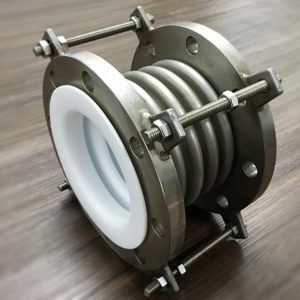Expansion Joints Based on different parameters such as the direction of movements, location the joint is placed, function of the joint, etc, there are a few different types of expansion joints. These are as follows –
-
Axial Expansion Joints
These are expansion joints that are used to contain the movement in the axial or longitudinal direction. When used in between two pipe sections, due to the thermal expansion, this joint compresses and expands along the length as required, thereby protecting the pipeline.
-
Lateral Expansion Joints
This type of metallic expansion joints is used to compensate all the movements in the lateral (perpendicular to the central axis) direction. With the help of control rods attached, the lateral expansion joints also control the pressure thrust.
-
Hinged Expansion Joints
A hinged expansion joint is used where there is a need to constrain angular deflections in a single plane controlled by a hinge. These are used in piping systems where there is a change in the direction of the flow.
-
Universal Expansion Joints
Universal expansion joints, also sometimes known as a double bellow expansion joint is a device that is made up of 2 bellows attached together by a pipe section. As a result, this can absorb movements that cannot be absorbed in normal axial expansion joints and can also contain deflections in axial, lateral, and angular directions.
-
Gimbal Expansion Joints
Gimbal expansion joints or the angular expansion joints are used to absorb movements in multiple angular directions. With the help of multiple hinges or gimbal, these can constrain the deflections in all the planes.
-
Inline Pressure Balanced Expansion Joints
Inline pressure balanced expansion joints are designed to absorb axial movement without putting a load on the pipe system. This is done by using two bellows in line together and acting in opposite directions. It is mainly used in systems where any pressure on the piping system can prove to be fatal, and therefore must be avoided.
-
Elbow Pressure Balanced Expansion Joints
This type of pressure balanced expansion joint is used in systems where it is not acceptable to transfer pressure on to the piping system and also there is a change in the direction of the flow. These absorb axial movement without imposing pressure loading on the system.
-
Externally Pressurized Expansion Joints
These are used in areas where there is a need to contain very high axial deflections due to very high pressure. Normal axial expansion joints have limitations in how much load they can absorb as the medium passes through the bellows. However. In the externally pressurized system, the medium is made to flow along the outer of the bellows. This, in theory, lets the system absorb indefinite movement axially.
-
Pump Connectors Expansion Joints
As the name suggests, these expansion joints are used in connecting a pump where there is a need to protect critical components of the system from vibrations and fluid pulsations, as well as to dampen the noise. These are usually made from steel.
-
Exhaust Bellows Expansion Joints
This type of joint is used in the exhaust systems of engines. Usually, exhaust pipes are positioned close to the engines, and as a result, are subject to high pressure and vibrations from the engine along with the high-temperature exhaust gases flowing through them. The exhaust bellows expansion joints help in controlling the thermal expansion and mechanical deformations due to this, along with damping the vibrations. These are also gas-tight to ensure there is no leakage of the gases.
-
Rectangular Bellows Expansion Joints
These are used in ducts in the petrochemical industry, nuclear power plants, steel industry, etc to absorb lateral and axial movements in the ducts. As a result, these are shaped in a rectangular form and are available in various dimensions and number of convolutions as required by the client.
-
Heavy Wall Expansion Joints
The simplest form of the expansions joints, this type is basically manufactured as the bellow alone as they can be easily welded on to the required connection. These can absorb small thermal axial movements.



